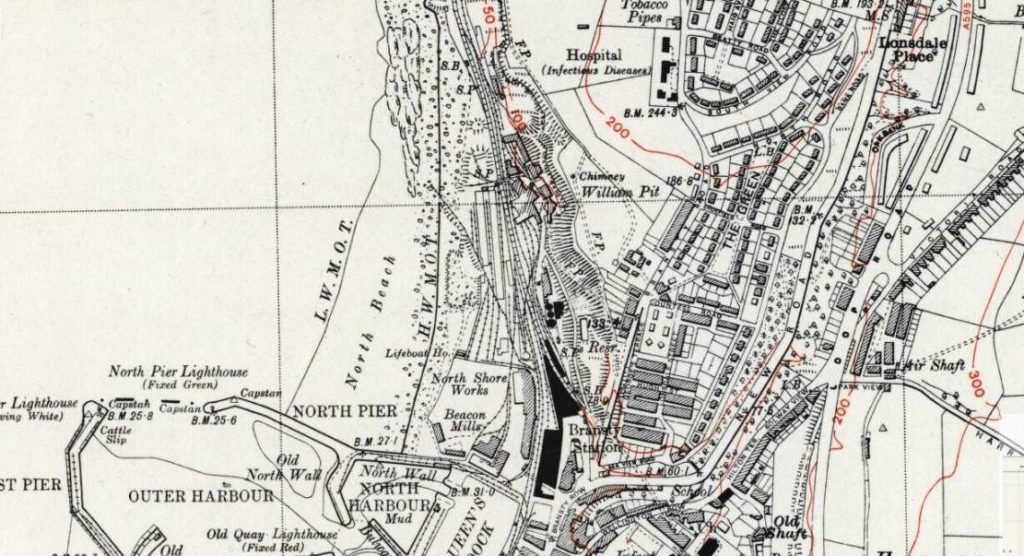The William Pit was one of three mines owned by the Cumberland Coal Company (Whitehaven) Limited. The mines was acquired by this Company in March 1937 and previous to that it had been idle for two years. The other pits were the Haigh and the Wellington Pits. They were all sunk close to the sea shore near Whitehaven and the coal that they worked was under the sea. The William Pit was a few hundred yards north of the L.M.S. Railway station and it had two shafts which dated from the early nineteenth century. The shafts were originally sunk to the Six Quarter Seam at 297 yards but after some time the lower part of the shaft was abandoned and winding was carried on from an inset 10 yards below the Main Band seam which was intersected at 208 yards.
The downcast was 15 feet in diameter and was the winding shaft. the upcast was 13 feet in diameter and was used solely for ventilation. There were three other means of egress to the surface through the Wellington and Haigh Pits and a day drift from the workings of the Haigh Pit. These were reached by a communication road from the William Pit workings.
Three seams had been worked at the colliery. The Main Band had been extensively worked and the seam averaged 10 feet of clean coal. It was worked by pillar and bord and there had been much splitting and robbing of the pillars. Generally, the pillars were left at their original dimensions of an average of about 20 yards square.
The main intake airway from the downcast shaft was the main haulage road to Lowca Junction. Originally it had an irregular gradient due to displacements of the seam and faults which it crossed. About 1908 a new road was set out with an even gradient from the downcast shaft at Lowca Junction and this permitted endless rope haulage in one reach between these two points. The new road was 4,000 yards long and was in the stone below the seam which minimalized the air leakage between the intake and the return airways. Haulage from the Countess Bannock District to the Lowca terminus of the haulage road was by a subsidiary endless rope driven by an electric motor installed immediately above the haulage road near the bottom of the incline.
Many lives have been lost at this pit from explosions through the years:
- In 1806 there was an explosion at a colliery in Whitehaven which caused the death of eleven men and boys. (the name of the pit is not mentioned and therefore might not be William Pit)
- On 18th February, 1839 there was an explosion at the colliery about one and a half miles from the shaft bottom in the direction of Parton which claimed the lives of nine men and twelve boys. The explosion was due to a boy taking a lighted candle into the mine. The full report can be found here.
- On 26th November, 1907 there was an explosion in a stone drift known as No.6 or Taffy’s Drift which was being driven from the air intake and endless rope haulage road leading to the Lowca and Countess districts in the workings which were under the sea in the Main seam at the colliery. As a result five men were killed and seven were injured. The reason for the explosion was unknown, but insufficient ventilation caused a build up of methane. The full report can be found here.
- On 3rd June, 1941 an explosion occurred claiming the lives of 12 men and injuring 11 others. Records indicate that since at least 1910 there had been many instances of spontaneous combustion in the pit. The explosion occurred in a large sealed off area which had been abandoned since 1928. The explosion was caused by an inflammable gas produced by the application of water to a considerable mass of glowing coal. The full report can be found here.
- The worst explosion occurred on 21st August, 1947 when 104 men lost their lives following a violent explosion in the main haulage road about two and a half miles from the shaft. The explosion was due to the igniting of gas in a break in shot-hole during shot-firing to bring down the coal. The full report can be found here.

OS Map, Cumberland LXVII.NW 1938
Reproduced by permission of the National Library of Scotland

